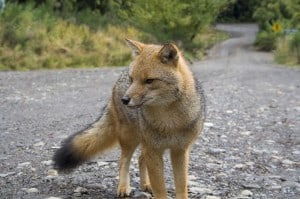Early in February at around 4:45 p.m. my husband and I saw what we are quite sure was a Grey Fox right behind our house here in Peterborough. It was grey in body colour with a black tail. It had a thicker body than a Red Fox, was sturdier looking and with shorter legs.The Gray Fox looks much different from the Red Fox.
We have had a chance to observe a Red Fox family at our farm. They lived under our shed. The female had 6 kits and she and the male took turns hunting and looking after the kits. We watched them the whole summer until they were old enough to leave on their own.I have never seen a Grey Fox before and was surprised to learn that they can climb trees. I live on the new part of Carriage Lane which backs onto a bit of bush edging a farmer’s field.
Cathy Nash, Carriage Lane, Peterborough
Note: The Grey Fox is the size of a small dog and looks very similar to the familiar Red Fox. But unlike the Red Fox, the Grey Fox has grizzled grey fur with lighter cinnamon coloured patches on its body. It also has a black tail tip, while the Red Fox has a white tail tip. The Grey Fox has shorter legs and a smaller snout than the Red Fox, and it can have a very long bushy tail. In Ontario, its historic range is across the southernmost portions of the province. In recent years, this range has been reduced to west of Lake Superior in the Rainy River District and on Pelee Island in west Lake Erie. There have been occasional sightings and reports of the Grey Fox close to the U.S. border in the Niagara, Thousand Islands and Windsor areas. It is a Species at Risk (Threatened) in Ontario. Source: OMNR “species at risk” website
